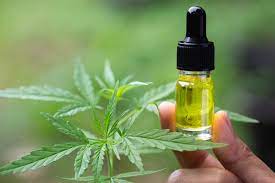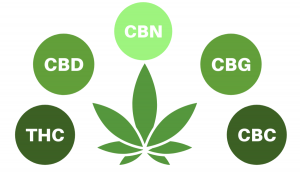Is marijuana the exact same as cannabis?
Although people often interchangeably use the terms “cannabis”, “marijuana”, and “marijuana,” they are not the same thing.
- All products that are derived from the plant Cannabis Sativa are called “cannabis”.
- There are approximately 540 chemicals in cannabis plants.
- Marijuana refers to products or parts of the cannabis sativa plant that contain high amounts of tetrahydrocannabinol. THC is the main ingredient responsible for marijuana’s effects on the mind. THC is very low in some cannabis plants. These plants are not considered marijuana, but “industrial hemp” under U.S. law.
This fact sheet uses the term “cannabis”, to refer to the Cannabis Sativa plant.
What are cannabinoids and how do they work?
Cannabinoids is a grouping of substances found in cannabis plants.
What are the main cannabinoids of cannabis?
THC (THC) and cannabidiol, (CBD) are the main cannabinoids.
What are the cannabinoids?
More than 100 cannabinoids, including CBD and THC, have been identified.
Is cannabis and cannabinoids legal for medical use in the United States?
The FDA has not approved cannabis for medical use. The FDA has however approved multiple drugs that contain cannabinoids.
- Epidiolex is a CBD-derived extract that has been purified from cannabis. It was approved to treat seizures associated with Dravet syndrome and Lennox Gastaut syndrome. These are two severe, rare forms of epilepsy.
- The FDA approved Syndros and Marinol, which contain synthetic THC (synthetic THC) and Cesamet (which contains nabilone, a synthetic substance that is similar to THC). Dronabinol or nabilone can be used to treat nausea and vomiting due to cancer chemotherapy. People with HIV/AIDS may also use Dronabinol to treat weight loss and loss of appetite.
Are dietary supplements and foods that contain CBD or THC legal?
THC and CBD products cannot legally be sold as dietary supplements by the FDA. Interstate commerce cannot legally sell food containing THC or CBD. It is up to the state’s laws and regulations whether they are legal to sell within their state.
Can cannabis and cannabinoids be used to treat health conditions?
Cannabinoids and drugs containing them may help with certain forms of epilepsy and nausea and vomiting associated with chemotherapy for cancer and weight loss and loss of appetite related to HIV/AIDS. Some evidence also suggests that cannabis and cannabinoids may be beneficial for chronic pain and multiple Sclerosis symptoms. Glaucoma is not treated with cannabis. The early stages of research on cannabis and cannabinoids to treat other conditions are still in their infancy.
These sections summarize the research that cannabis and cannabinoids have done for certain health conditions.
Pain
- There has been research on the effects cannabis and cannabinoids have on chronic pain, especially neuropathic pain (pain that is caused by nerve injury or damage).
- The 2018 review examined 47 studies (4743 participants) on cannabis/cannabinoids for chronic pain. It found evidence of a slight benefit. Twenty-nine percent of people taking cannabis/cannabinoids had a 30 percent reduction in their pain whereas 26 percent of those taking a placebo (an inactive substance) did. Patients may not be able to see the difference. Adverse events (side effects) were more common among people taking cannabis/cannabinoids than those taking placebos.
- An 2018 review of 16 studies on cannabis-based pain medications for neuropathic pain found that the majority of them tested a cannabinoid preparation called nabiximols. This mouth spray containing THC and CBD is approved in certain countries, but not in the United States. The reviews showed that these medicines provided better pain relief than placebos. The data was unreliable as it only included a small number of subjects and could have been biased. Side effects were more common in people who took cannabis-based medicine than in placebos.
- The 2015 review of 28 studies (2.454 participants) on cannabinoids and chronic pain found that there was generally an improvement in pain measures for people who took cannabinoids. However, these improvements did not reach statistical significance in all of the studies. The average number of cannabinoids-treated patients with pain relief greater than placebo was 30 percent.
Contributing to the Decrease of Opioid Use
- Studies in animals have shown that THC can be combined with opioids to reduce pain.
- A 2017 review examined studies that included cannabinoids being administered alongside opioids to relieve pain. These studies sought to find out if cannabinoids could be used to reduce pain using smaller doses of opioids. There were nine studies with 750 participants. Three of them (642 participants) employed a high-quality design that randomly assigned participants to either cannabinoids (or a placebo). There was no evidence that cannabinoids might reduce opioid use, and the results were inconsistent.
- Researchers looked at statistical data from groups of people to determine if access to cannabis (for instance, through “medical cannabis laws”-state laws that allow patients to access cannabis) is linked to changes in opioid use and/or the harm associated with opioids. These findings were inconsistent.
- The prescription rates for opioids and all other drugs that cannabis can substitute for were lower in states with medical marijuana laws. Data from a nationwide survey, not just for Medicare recipients, showed that medical marijuana users were more likely to report prescription drugs than nonusers.
- A comparison of 1999-2010 showed that states with medical cannabis laws had lower overdose rates for opioid pain medications. However, a 2017 analysis revealed higher overdose rates.
- A survey analysis from 2004 to 2014 showed that medical marijuana laws were not associated with lower non-medical prescription opioid usage. People with medical marijuana access did not seem to be replacing prescription opioids by using it.
Anxiety
- According to studies done in humans, there is limited evidence that CBD or cannabinoids may help reduce anxiety. A study of 24 people suffering from social anxiety disorder showed that CBD caused anxiety to be lower in the simulated public speaking test. Four studies suggest that CBD may help with anxiety in chronic pain patients. However, the participants were not diagnosed with anxiety disorders.
Epilepsy
- CBD and other cannabinoids have been investigated for treating seizures that are associated with epilepsy. The FDA approved Epidiolex (oral CBD), for treating seizures related to two epileptic conditions: Lennox–Gastaut and Dravet. Epileptic encephalopathies (or epileptic seizures) are a type of seizure disorder that can start in childhood. They cause frequent seizures and severe cognitive impairments. Cannabinoids have not been extensively researched for epilepsy.
Glaucoma
- Glaucoma can be a grouping of diseases that can cause damage to the optic nerve in the eye, leading to vision loss or blindness. Glaucoma can be prevented by early treatment. The disease can be slowed down by lowering the pressure within the eye.
- In the 1970s and 1980s, studies showed that cannabis or other substances derived from it could lower eye pressure. However, this was not as effective as existing treatments. The only problem with cannabis-based products is their ability to lower pressure in the eyes for a brief time.
- Recent animal studies have shown that CBD applied directly to the eyes can cause an unfavorable increase in pressure.
HIV/AIDS Symptoms
- People living with HIV/AIDS can experience unintentional weight loss. The FDA approved using the cannabinoid dronabinol to treat weight loss caused by HIV/AIDS in 1992. The FDA approved the dronabinol for treating weight loss in HIV/AIDS patients based on a study that included 139 participants.
- Although there were a few studies on cannabis and cannabinoids about appetite and weight loss among people living with HIV/AIDS, they were brief and did not include many people. Their results could have been biased. Overall, the evidence that cannabis/cannabinoids are beneficial in people with HIV/AIDS is limited.
Inflammatory Bowel Disease
- Inflammatory bowel diseases are conditions that cause inflammation of the digestive tract. Crohn’s and ulcerative colitis are the most common. You may experience diarrhea, abdominal pain, weight loss, nausea, vomiting, and fever. They can be mild or severe and disappear for several months or years before returning.
- In 2018, a review of three studies (93 participants) looked at whether smoking cannabis or cannabis oil was better than placebos for people with active Crohn’s disease. In clinical remission of Crohn’s disease, there was no difference in the effectiveness of cannabis/cannabis oil versus placebo. While some people who used cannabis oil or cannabis oil experienced improvements in their symptoms, others suffered undesirable side effects. It wasn’t clear if the benefits of cannabis oil or cannabis oil outweighed the potential harms.
- In 2018, a review looked at 2 studies that compared CBD capsules or smoked cannabis to people with active ulcerative colitis. It included 92 participants. The CBD study showed no difference in clinical remission between the two groups, however, CBD capsules had more side effects. The smoked cannabis study showed that disease activity decreased after 8 weeks, but no information was available on side effects.
Irritable Bowel Syndrome
- Irritable Bowel Syndrome (IBS) refers to persistent abdominal pain that causes changes in bowel movements, such as constipation, diarrhoea, or both. It is one of several functional disorders in the gastrointestinal tract (GI), which relate to the interplay between the gut and brain.
- Although there’s interest in using cannabis/cannabinoids for symptoms of IBS, there’s been little research on their use for this condition in people. It is not known if cannabis or cannabinoids are helpful.
Tourette Syndrome: Movement Disorders
- Two small, placebo-controlled studies that included 36 patients with Tourette syndrome found that synthetic THC capsules were associated with an improvement in the severity of tic symptoms in Tourette syndrome patients.
Multiple Sclerosis
- Multiple sclerosis symptoms can be treated with a variety of cannabis/cannabinoid products, including dronabinol and nabilone.
- The results of 17 studies involving a variety cannabinoid preparations and 3,161 participants showed that cannabinoids did not significantly improve spasticity as measured by objective tests.
- The results of six placebo-controlled clinical trials involving 1,134 participants showed that cannabinoids (nabiximols and dronabinol) were associated with an average improvement in spasticity in patients with multiple sclerosis compared to placebo. However, this was not statistically significant.
- The American Academy of Neurology issued evidence-based guidelines in 2014. They concluded that nabiximols was likely to improve subjective spasticity symptoms. However, it is unlikely to reduce objective spasticity measures, bladder incontinence or decrease in spasticity. It may also not be effective in reducing multiple-sclerosis-related seizures. The guidelines concluded that there is not enough data to assess the effects of smoking cannabis on multiple sclerosis patients based on two small studies.
- An analysis of 3 studies (66 participants) on nabiximols and multiple sclerosis in people with spasticity and subjective spasticity in 2010 found that nabiximols decreased subjective spasticity. About one-third of those who received nabiximols along with other treatments had at least a 30% improvement in spasticity. Nabiximols were found to be relatively safe.
Cancer chemotherapy can cause nausea and vomiting.
- Research on dronabinol, nabilone and nausea related to chemotherapy for cancer was conducted primarily in the 1980s & 1990s. In 2015, 23 studies (1.326 participants) were reviewed on cannabinoids dronabinol and nabilone to treat nausea and vomiting caused by cancer chemotherapy. The results showed that they were more effective than a placebo and comparable to other drugs used for this purpose. Side effects like dizziness and sleepiness were more common with cannabinoid medications than the placebo.
- This reflects current antinausea medications and the type of chemotherapy available at the time.
Posttraumatic Stress Disorder (PTSD).
- People with PTSD may have tried cannabis and products made from it to alleviate their symptoms. However, there has been very little research to prove effective.
- One small study (ten people) showed that the cannabinoid nabilone was better than a placebo in relieving PTSD-related nightmares.
- Observational studies, which collect data from people with PTSD and make their own decisions about cannabis use, have not provided any clear evidence to support the claim that cannabis is beneficial or harmful for PTSD symptoms.
Sleep problems
- Numerous studies have examined the effects of cannabis and cannabinoids on sleep in patients with chronic pain, multiple sclerosis, PTSD or other health issues. Often, there’s been evidence of better sleep quality, fewer sleep disturbances, or decreased time to fall asleep in people taking cannabis/cannabinoids. It is not clear if cannabis products directly affected sleep or if people slept better after their symptoms had improved. The effects of cannabis/cannabinoids on sleep problems in people who don’t have other illnesses are uncertain.
Is cannabis and cannabinoids considered safe?
There have been many concerns about cannabis safety and cannabinoids.
- Cannabis use has been associated with an increase in motor vehicle accidents.
- Lower birth weight has been associated with smoking cannabis during pregnancy.
- People who smoke cannabis may develop cannabis use disorder. This condition causes cravings, withdrawals, loss of control, and other negative effects on their professional and personal lives.
- The likelihood of developing a cannabis-related disorder in adolescents who use cannabis is four to seven times higher than adults.
- Older adults are at greater risk from injury due to cannabis use.
- People predisposed to developing these mental disorders are at greater risk from using cannabis frequently.
- Marijuana can cause orthostatic hypotension, a head rush or dizziness when standing up. This could increase the risk of fainting and falls.
- The FDA has warned THC-containing vape products. These products have been linked to many cases of severe lung injury due to vaping.
- Many cases of children consuming cannabis products or unintentionally ingesting it have been reported. These illnesses can be severe enough to warrant hospital admission or emergency room treatment. Children exposed to THC candy accidentally became more sick than adults, and had to be admitted to the hospital for longer periods.
- Recurrent severe vomiting is a common side effect of long-term cannabis users.
- Reports have come out of the United States that cannabis/cannabinoid product has been contaminated with pesticides or microorganisms.
- Certain cannabis/cannabinoid products may contain cannabinoids in significantly different amounts from the ones listed on their labels.
Is CBD safe?
Some CBD could be dangerous for some people, according to evidence.
Studies were conducted to assess the safety and effectiveness of Epidiolex, a purified CBD oil product, before FDA approved it. Side effects such as sleepiness or diarrhea were common in the studies. Some also developed abnormalities on liver function tests. Some study participants were forced to stop taking Epidiolex due to liver problems. Epidiolex could also interact with other drugs that they were currently taking.
This protection is not available to people using CBD on their own. It is possible that they don’t even know how much CBD their bodies are consuming. Patients who take Epidiolex can manage such problems because they use CBD under medical supervision. An analysis of 84 CBD products online revealed that 26% contained significantly less CBD than the label stated, while 43% contained substantially more.



